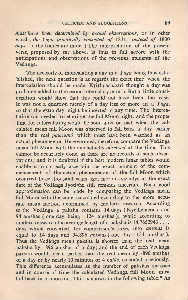Page 711 - Lokmanya Tilak Samagra (khand 2)
P. 711
CRITICISM AND SUGGESTIONS 63
must have been determined by actual observations, or in other
words, the Yuga practically consisted of 1831, instead of 1830
days. ' ( the Italics are mine. ) The interpretation of the present
verse, proposed by me above, is thus in full accord with the
anticipations and observations of the previous students of the
Vedanga.
The necessity of intercalating a day in a Yuga being thus esta-
blished, the next question is as regards the exact time when the
ihtercalation should be made. Kri'h~ashastri thought a day was
probably added to the second intercalary month. But a little consi-
deration would show that this could not have been the case.
It was not a question merely of a day less or more in a Yuga,
so that the extra day might be inserted at any time. The interca-
lation was needed to set aright the full Moon night; and the proper
time for intercalating would be soon after or just when the cal-
culated mean full Moon was observed to fall back a day earlier
than the real paurnimd, which must have been watched as an
actual phenomenon. Here we must, therefore, compare the Vedanga
mean full Moon with the one actually observed at the time. This
cannot be accurately done, as there are no records of such obser-
vations; and it is doubtful if the best modern lunar tables would
enable us to correctly ascertain the exact moment of the com-
mencement of the actual phenomenon of the full Moon which
occurred three thousand years ago, more especiallya as the exact
date of the Vedanga Jyoti,ha still remains uncertain. But a good
approximation can be made by comparing the Vedanga mean
full Moon with the same, calculated according to the more accu-
rate mean motion determined by modern research. According
to the Vedanga a paksha contains 14 days (Nycthemera) and
94 amshas (one day being= 124 amshas ); while according to
modern reesearch the average length of a paksha is 14.7652943 ....
days which converted, for comparison's sake, into amshas is
equal to 14 days and 94.896 amshas (one day= 124 amshas ).
Thus the Vedanga mean paksha is shorter than the real mean
paksha by ·896 amshas of a day; and the end of each Vedanga
parvan would occur earlier than the real mean by · 896 amshas
of a day or by nearly 10 minutes or 4 ka/as, as stated previously.
This difference accumulates as the number of pakshas increase
and in course of time the calculated Vedanga full Moon must
fall back in proportion. This is shown in the following table. • As

